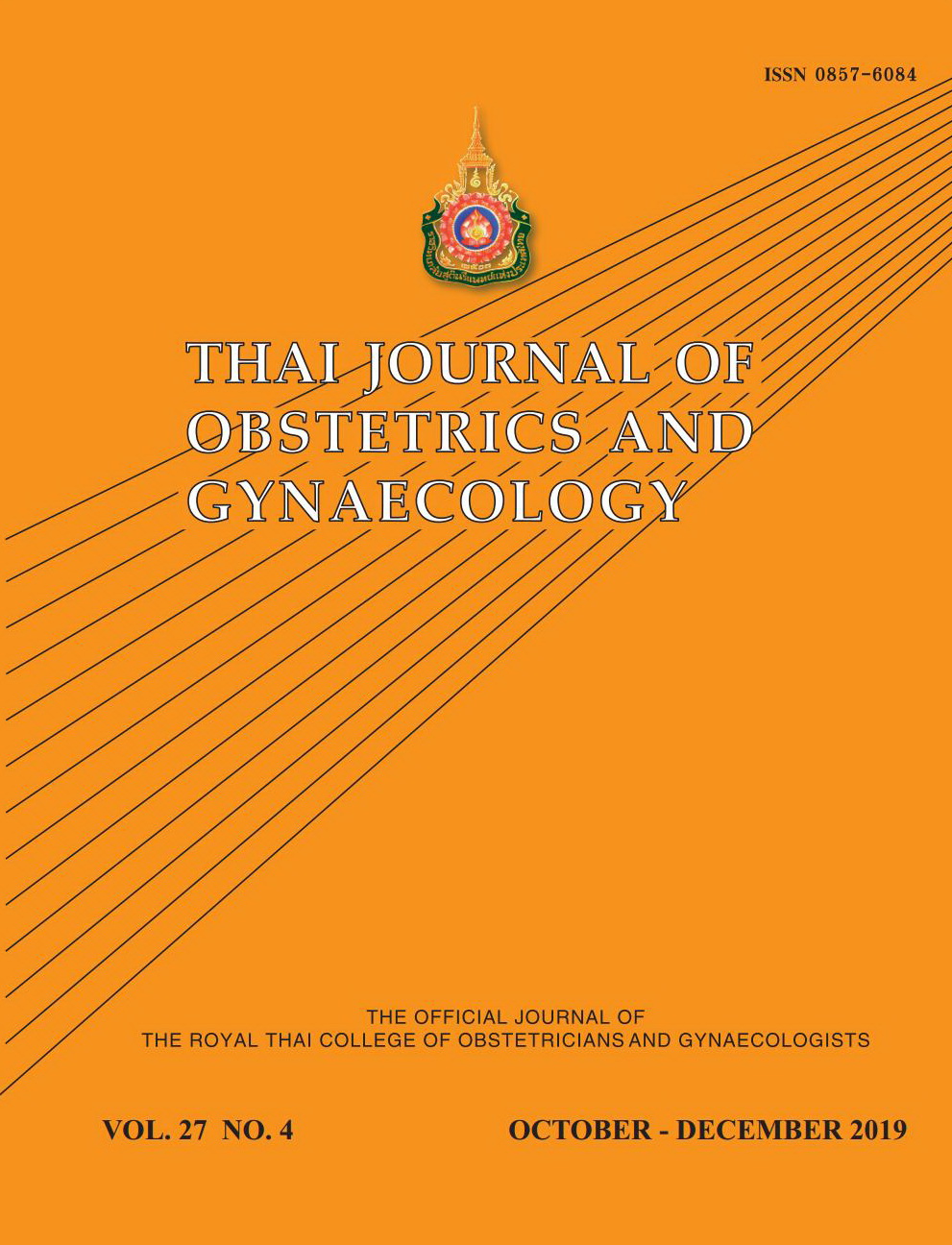Subsequence Pregnancy Outcomes after Treatment of Gestational Trophoblastic Disease in King Chulalongkorn Memorial Hospital
Main Article Content
Abstract
Objective: To review subsequent pregnancy outcome in gestational trophoblastic disease (GTD) patients at King Chulalongkorn Memorial hospital.
Materials and Methods: Retrospective cohort study was done between 2001 and 2015. Women whom diagnosed with gestational trophoblastic disease at King Chulalongkorn Memorial Hospital, Bangkok, Thailand were recruited. Data were reviewed by medical record and telephone interview regarding subsequent pregnancy outcome and clinical data.
Results: There were 147 GTD patients enrolled during study period, 82 pregnant women were observed. Final diagnosis was complete hydatidiform mole 40 cases (48.78%), partial hydatidiform mole 11 cases (13.41%), postmolar gestational trophoblastic neoplasia 28 cases (34.15%) and non-molar gestational trophoblastic neoplasia 3 cases (3.66%). Mean age at diagnosis was 25.04 years (range 14-36 years). Median interval from remission to subsequent pregnancy was 36 months (range 3-132 months). There were 80 from 82 cases spontaneous pregnancy. Three patients (3.66 %) was pregnant before 1 year. For first subsequent pregnancy outcomes, 71 cases (86.66%) were term live birth, 3 cases (3.66%) were preterm birth and 8 cases (9.76%) were spontaneous abortion. There was no significant difference in pregnancy outcomes between patients who received chemotherapy and who did not receive chemotherapy treatment. Similarly, patients who received single agent chemotherapy and multi-agent chemotherapy had no significant difference in pregnancy outcomes.
Conclusion: Around 86% of subsequent pregnancy after GTD remission were term live birth. Subsequent pregnancy outcomes after GTD were not significantly different between patients with hydatidiform mole and gestational trophoblastic neoplasia.
Article Details
References
2. Yanaranop M, Potikul C, Tuipae S. A 10-Year clinical experience of gestational trophoblastic disease at Rajavithi Hospital, 2001-2010. J Med Assoc Thai 2016;99Suppl 2:S17-27.
3. Wairachpanich V, Limpongsanurak S, Lertkhachonsuk R. Epidemiology of hydatidiform moles in a tertiary hospital in Thailand over two decades: Impact of the National Health Policy. Asian Pac J Cancer Prev 2015;16:8321-5.
4. Lertkhachonsuk R, Wairachpanich V. Treatment outcomes of gestational trophoblastic neoplasia in King Chulalongkorn Memorial Hospital over two decades. J Reprod Med 2016;61:238-42.
5. Eysbouts YK, Bulten J, Ottevanger PB, Thomas CM, Ten Kate-Booij MJ, van Herwaarden AE, et al. Trends in incidence for gestational trophoblastic disease over the last 20 years in a population-based study. Gynecol Oncol 2016;140:70-5.
6. Vargas R, Barroilhet LM, Esselen K, Diver E, Bernstein M, Goldstein DP, et al. Subsequent pregnancy outcomes after complete and partial molar pregnancy, recurrent molar pregnancy, and gestational trophoblastic neoplasia: an update from the New England Trophoblastic Disease Center. J Reprod Med 2014;59:188-94.
7. Kim JH, Park DC, Bae SN, Namkoong SE, Kim SJ. Subsequent reproductive experience after treatment for gestational trophoblastic disease. Gynecol Oncol 1998;71:108-12.
8. Sebire NJ, Fisher RA, Foskett M, Rees H, Seckl MJ, Newlands ES. Risk of recurrent hydatidiform mole and subsequent pregnancy outcome following complete or partial hydatidiform molar pregnancy. BJOG 2003;110:22-6.
9. Woolas RP, Bower M, Newlands ES, Seckl M, Short D, Holden L. Influence of chemotherapy for gestational trophoblastic disease on subsequent pregnancy outcome. BJOG 1998;105:1032-5.
10. Ngan HY, Bender H, Benedet JL, Jones H, Montruccoli GC, Pecorelli S, et al. Gestational trophoblastic neoplasia, FIGO 2000 staging and classification. Int J Gynaecol and Obstet 2003;83 Suppl 1:175-7.
11. Joneborg U, Eloranta S, Johansson AL, Marions L, Weibull CE, Lambe M. Hydatidiform mole and subsequent pregnancy outcome: a population-based cohort study. Am J Obstet Gynecol 2014;211:681 e1-7.
12. Wang X, Chen C, Wang L, Chen D, Guang W, French J. Conception, early pregnancy loss, and time to clinical pregnancy: a population-based prospective study. Fertil Steril 2003;79:577-84.
13. Wilcox AJ, Weinberg CR, O'Connor JF, Baird DD, Schlatterer JP, Canfield RE, et al. Incidence of early loss of pregnancy. New Engl J Med 1988;319:189-94.
14. Garrett LA, Garner EI, Feltmate CM, Goldstein DP, Berkowitz RS. Subsequent pregnancy outcomes in patients with molar pregnancy and persistent gestational trophoblastic neoplasia. J Reprod Med 2008;53:481-6.
15. Gadducci A, Lanfredini N, Cosio S. Reproductive outcomes after hydatiform mole and gestational trophoblastic neoplasia. Gynecol Endocrinol 2015;31:673-8.
16. Leenharattanarak P, Lertkhachonsuk R. Quality of life in gestational trophoblastic neoplasia patients after treatment in Thailand. Asian Pac J Cancer Prev 2014;15:10871-4.

